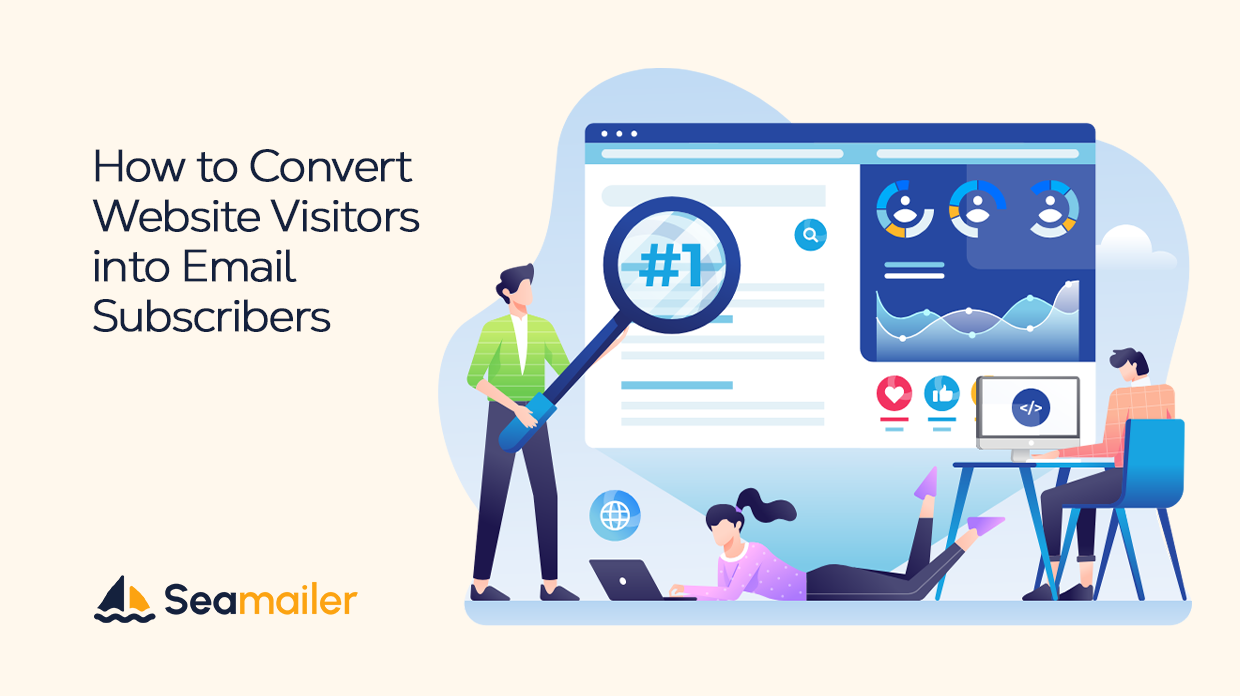How to Convert Website Visitors into Email Subscribers

In the bustling digital marketplace, capturing a visitor's attention is only half the battle. The real challenge lies in converting that fleeting interest into a lasting connection.
And in digital marketing, few connections are as valuable as an email subscriber. Your email list is a direct line to your most engaged audience, a powerful channel for nurturing leads, building loyalty, and driving sales. But with inboxes overflowing and attention spans dwindling, how do you stand out? The answer, increasingly, lies in personalization.
Gone are the days of one-size-fits-all email blasts. Today's consumers expect experiences tailored to their individual needs and preferences. They crave relevance, and they'll quickly tune out anything that feels generic or impersonal. This isn't just a trend; it's a fundamental shift in consumer behavior driven by the sheer volume of information available. In this environment, personalized email campaigns are not just a nice-to-have; they are a strategic imperative. They are the key to unlocking higher email conversions, fostering deeper customer engagement, and ultimately, achieving sustained growth.
This comprehensive guide will delve into the transformative power of email personalization, offering actionable insights, data-backed strategies, and real-world examples. Whether you're a seasoned marketer, a startup founder, a burgeoning creator, or an SMB owner, you'll discover how to leverage personalization to dramatically increase your email subscriber rates and elevate your entire email marketing strategy.
The Data-Backed Case for Email Personalization
The evidence is overwhelming: personalization works. Study after study confirms that tailoring email content to individual recipients leads to significantly better results across the board.
- Higher Open Rates: Personalized subject lines can increase open rates by 50% or more. Think about it: a subject line that speaks directly to a recipient's interests or recent actions is far more compelling than a generic one.
- Increased Click-Through Rates (CTRs): When the content inside the email is relevant to the recipient, they are far more likely to click on your calls to action. Personalized calls to action can perform 202% better than non-personalized ones.
- Improved Conversion Rates: Ultimately, the goal of any marketing effort is conversion. Personalized emails drive 6x higher transaction rates and revenue per email than non-personalized emails.
- Reduced Opt-Out Rates: When subscribers feel valued and understood, they are less likely to unsubscribe. Personalization demonstrates that you respect their time and preferences.
- Enhanced Customer Engagement: Beyond immediate conversions, personalization builds stronger relationships. It shows customers you understand their needs, fostering trust and loyalty.
These statistics aren't just numbers; they represent a fundamental shift in how effective email marketing is conducted. Ignoring personalization in today's landscape is akin to leaving money on the table.
Understanding Your Audience: The Foundation of Personalization
Before you can personalize, you must understand. The bedrock of any successful email personalization strategy is a deep understanding of your audience. This goes beyond basic demographics; it requires insight into their behaviors, preferences, pain points, and motivations.
1. Data Collection and Segmentation
The journey begins with gathering the right data. Every interaction a visitor has with your website, social media, or other touchpoints provides valuable clues.
- Website Behavior: What pages do they visit? What products do they view? How long do they stay on certain pages? What content do they download?
- Purchase History: What have they bought in the past? How often do they purchase? What is their average order value?
- Demographic Information: (While not the only factor, basic demographics like location, age, and gender can still be useful for broad segmentation).
- Preference Centers: Allow users to explicitly state their interests and how often they want to receive emails.
- Survey Responses: Ask your audience directly about their preferences and needs.

Once you have this data, segment your audience into smaller, more homogeneous groups. Common segmentation criteria include:
- New Visitors vs. Returning Visitors: Different messages resonate with those just discovering your brand versus loyal customers.
- Engaged vs. Disengaged Subscribers: Tailor re-engagement campaigns for inactive users.
- Product/Service Interest: Segment based on the specific categories or services they've shown interest in.
- Demographics: While not the sole focus, age, location, or industry can still be relevant.
- Behavioral Triggers: Segment based on actions like abandoning a cart, downloading a lead magnet, or visiting a specific product page.
Imagine a finely tuned engine, where each component works in harmony to deliver peak performance. Data collection and segmentation are the fuel and mechanics for your personalized email campaigns.
2. Crafting Buyer Personas
Beyond raw data, develop detailed buyer personas. These are semi-fictional representations of your ideal customers, based on real data and educated guesses about demographics, behavior patterns, motivations, and goals. Give them names, backstories, and even images. This exercise helps you empathize with your audience and craft messages that genuinely resonate.
Actionable Strategies for Personalized Email Campaigns
Once you understand your audience, it's time to put that knowledge into action. Here are several powerful strategies for implementing email personalization throughout your email marketing strategy.
1. Dynamic Content Based on User Behavior
Dynamic content is the cornerstone of advanced personalization. Instead of sending one static email, you can display different content blocks, images, or calls to action within the same email based on the recipient's data.
- Abandoned Cart Recovery: This is a classic and highly effective use of personalization. If a user adds items to their cart but doesn't complete the purchase, send a follow-up email displaying the exact items they left behind, perhaps with a gentle reminder or even a small incentive. This type of personalized email can recover a significant percentage of lost sales.
- Browse Abandonment: Similar to cart abandonment, if a user views specific product pages multiple times but doesn't add them to their cart, send an email showcasing those products or related items.
- Content Recommendations: For content-driven businesses (blogs, news sites, educational platforms), recommend articles, videos, or courses based on their past consumption or stated interests.
- Product Recommendations: E-commerce stores can leverage purchase history and browsing behavior to suggest complementary products ("Customers who bought this also bought...") or items they might be interested in.
- Location-Based Offers: If you have brick-and-mortar stores, send promotions or event invitations relevant to the subscriber's geographic location.
2. Personalized Subject Lines and Preheaders
The subject line and preheader are your email's first impression. Make them count by infusing them with personalization.
- First Name Personalization: A simple "[First Name], here's what's new for you!" can significantly boost open rates.
- Recent Action Reference: "Your cart is waiting, [First Name]!" or "New content based on your interest in [Topic]!"
- Location-Specific Information: "Events near you in [City]!"
- Urgency Based on Behavior: "Don't miss out on [Product] – last chance!"
3. Triggered Emails for Key Lifecycle Stages
Automated, triggered emails are inherently personal because they respond directly to a user's actions or inactions.
- Welcome Series: When a new visitor subscribes, don't just send a generic "thank you." Instead, create a personalized welcome series that introduces your brand, sets expectations, and offers immediate value. This is a critical opportunity to build trust and encourage early customer engagement.
- Example: Email 1: Welcome and introduce brand story. Email 2: Offer a beginner's guide or popular product. Email 3: Highlight social proof or customer testimonials.
- Onboarding Sequences: For SaaS or service-based businesses, guide new users through the initial steps of using your product with personalized tips and tutorials.
- Milestone Emails: Celebrate a customer's anniversary with your brand, their birthday, or when they reach a certain loyalty program tier. These small gestures can go a long way in building customer engagement.
- Re-engagement Campaigns: If a subscriber becomes inactive, send a series of emails designed to win them back. Offer a special incentive, remind them of the value you provide, or simply ask what kind of content they'd like to receive.
4. Personalizing the Sender Name and From Address
Even the "from" field can be personalized. Instead of a generic "Marketing Team," consider sending emails from a specific person's name (e.g., "Sarah from [Your Company]") or a personalized department (e.g., "Support Team at [Your Company]"). This adds a human touch and can increase trust and open rates.
5. Leveraging Predictive Analytics
For more advanced personalization, predictive analytics uses machine learning to forecast future customer behavior. This can inform:
- Next Best Offer: What product or service is a customer most likely to purchase next?
- Churn Risk: Identify customers who are likely to disengage or unsubscribe so you can proactively intervene with targeted offers or support.
- Lifetime Value (LTV): Understand which customers are most valuable and tailor loyalty programs or exclusive content accordingly.
Implementing Personalization: A Guide for Different Audiences
Email personalization isn't just for large enterprises with vast resources. Marketers, startup founders, creators, and SMB owners can all implement effective strategies.
For Marketers: Scaling Personalization with Automation
As a marketer, your challenge is often scale. How do you personalize for thousands or even millions of subscribers without becoming overwhelmed?
- Invest in a Robust Email Service Provider (ESP): Choose an ESP that offers advanced segmentation capabilities, dynamic content blocks, A/B testing, and automation workflows. Look for tools that integrate with your CRM and other marketing platforms to consolidate data.
- Automate as Much as Possible: Set up drip campaigns for welcome series, abandoned carts, and re-engagement. Use conditional logic to trigger different email paths based on user actions.
- Focus on Key Segments First: Don't try to personalize every single email for every single subscriber from day one. Start with your most valuable segments or the most impactful personalization opportunities (e.g., abandoned carts) and expand from there.
- Continuously Test and Optimize: A/B test different personalized elements – subject lines, images, CTAs, and content blocks – to see what resonates best with your audience.

For Startup Founders: Building a Personalized Foundation from Day One
Startups have the advantage of agility and often a smaller, more manageable audience initially.
- Prioritize Data Collection: From your very first visitor, think about what data you need to collect to personalize their experience down the line. Implement tracking tools from day one.
- Embrace Early Feedback: Engage with your early adopters directly. Ask them about their needs and preferences. This qualitative data is invaluable for shaping your email marketing strategy.
- Focus on Solving Specific Pain Points: Personalize your messaging to directly address the unique problems your startup solves for different segments of your target audience.
- Leverage Lightweight Tools: Many ESPs offer free or affordable plans for startups, allowing you to implement basic segmentation and automation without a huge upfront investment.
For Creators: Deepening Connections Through Authenticity
For creators (bloggers, YouTubers, artists, coaches), personalization is about building a community and fostering a deeper connection with individual fans and followers.
- Segment by Content Preference: If you create diverse content, allow subscribers to choose which topics they want to hear about.
- Personalized Stories and Updates: Share behind-the-scenes glimpses or personal anecdotes that relate to their specific interests.
- Direct Interaction: Encourage replies to your personalized emails. Respond to comments and questions to build a genuine rapport.
- Exclusive Content for Engaged Fans: Offer personalized access to exclusive content, early releases, or Q&A sessions to your most loyal subscribers.
- Show Appreciation: Send personalized thank you notes or shout-outs to super-fans or those who have made significant contributions.
For SMB Owners: Practical Personalization with Limited Resources
SMBs often operate with limited time and budget, making efficient personalization crucial.
- Start Simple with First Name Personalization: Even just addressing subscribers by their first name can make a difference.
- Segment by Local Needs/Interests: If you're a local business, segment by neighborhood or specific local interests.
- Leverage Transactional Data: Use purchase history to send personalized recommendations, loyalty offers, or follow-up surveys.
- Create Simple Automation Workflows: Set up an automated welcome email and a basic abandoned cart sequence. These two alone can yield significant results.
- Utilize Your Expertise: Position yourself as a local expert in your field. Provide personalized tips or advice that directly addresses common customer questions.
- Ask for Feedback: Send short, personalized surveys to gather input on what customers want to see in your emails.
Measuring Success: KPIs for Personalized Email Campaigns
To ensure your email marketing strategy is effective, you need to track the right metrics.
- Open Rate: How many recipients are opening your emails? Personalized subject lines should boost this.
- Click-Through Rate (CTR): How many recipients are clicking on links within your emails? Personalized content and CTAs are key here.
- Conversion Rate: Of those who clicked, how many completed the desired action (e.g., made a purchase, downloaded a resource, signed up for an event)? This is the ultimate measure of email conversions.
- Unsubscribe Rate: Are your personalization efforts reducing churn?
- Revenue Per Email: How much revenue is each email generating on average? This is a strong indicator of ROI.
- Customer Lifetime Value (CLTV): Over time, personalization should contribute to higher customer retention and increased CLTV.
- Return on Investment (ROI): Are your personalization efforts generating more revenue than they cost?
Regularly analyze these KPIs to understand what's working and what needs refinement. Don't be afraid to experiment and iterate.
The Future of Email Personalization: Hyper-Relevance
As technology evolves, email personalization will become even more sophisticated, moving towards hyper-relevance.
- AI and Machine Learning: Advanced AI will process vast amounts of data to predict individual preferences with even greater accuracy, delivering truly bespoke content.
- Real-time Personalization: Emails will adapt in real-time based on current events, stock levels, or even the weather in the recipient's location.
- Interactive Emails: Emails will become more dynamic and interactive, allowing users to engage directly within the email itself, further enhancing the personalized experience.
The core principle, however, remains the same: understanding and serving the individual needs of your audience.
Conclusion: Transform Your Email Marketing with Personalization
Converting website visitors into email subscribers and then into loyal customers is an ongoing journey. In an age of information overload, generic approaches simply won't cut it. Personalized email campaigns are not just a tactic; they are the bedrock of a successful email marketing strategy. They demonstrate that you value your audience, understand their needs, and are committed to providing relevant, valuable experiences.
By collecting and leveraging data, segmenting your audience intelligently, and implementing dynamic content and triggered automations, you can dramatically improve your email conversions, foster unparalleled customer engagement, and build a thriving community around your brand.
Don't let your valuable website visitors slip away into the digital ether. Start embracing the power of personalization today and watch your subscriber list, engagement rates, and revenue soar.
Ready to create personalized email campaigns that convert at scale?
Try Seamailer today and unlock the full potential of your email marketing strategy!

